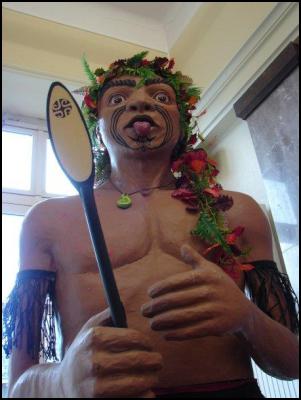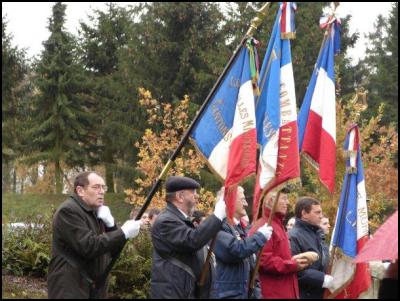From the uttermost ends of the earth
From the uttermost ends of the
earth

Every November in a small
corner of the French Republic, there is a party in New
Zealand’s honour. Once a year the people of Le Quesnoy
celebrate the anniversary of the day in November 1918, a
week before the Armistice that ended the First World War,
when brave New Zealand troops risked their lives to liberate
the town and its inhabitants from their German occupiers and
hasten the end of the war.
And the townsfolk have a particular reason to thank New Zealand and its soldiers, because on the night of 4 November 1918 a daring raid scaled the town’s seemingly impregnable fortress walls, surprising the German defenders and liberating the town without the terrible artillery pounding that befell so many other walled French towns.
Today Le Quesnoy still boasts its historic network of defensive walls and its beautiful traditional country architecture thanks to the exploits of the New Zealand Division, in what historians have called the most successful New Zealand assault of the entire war.

Today Le Quesnoy is
a quiet country town, its cobblestoned streets graced by a
happy abundance of chocolatiers and small cafes. But the
marks of the liberation of November 1918 are everywhere
through the town. Visitors can follow the Avenue des
Néo-Zélandais to the Garden of Remembrance where a marble
bas-relief carving hangs on the inner fortifications near
where Lt Leslie
Averill led a party of New Zealanders in a surprise night raid that precipitated the surrender of the German garrison of perhaps 2000 soldiers. Unveiled in 1923, the marble depicts a graceful winged Victory holding a laurel wreath over a party of New Zealanders lugging themselves up a ladder in the darkness, fully exposed to enemy fire and in great peril of discovery – the moment of greatest danger.

Averill’s actions are described in the Division’s official history:
‘Quietly they raised the ladder against the
wall. It reached the top of the bricks with a foot or two
to spare, resting against a 2-foot-high grassy bank which
crowned the rampart … Two of the riflemen steadied the
ladder on its insecure perch and Averill started to mount
it, telling the others that he would shout down to them from
the top if all was quiet … Averill quickly reached the top
of the brickwork and stepped over the coping onto the grassy
bank. Crouching behind it, he peered over. It was one of
the most dramatic moments in the Division’s history’
(Quoted in www.nzhistory.net.nz)
Taken by surprise, the German defenders fled, offering some firefights but little major resistance. The New Zealanders were treated as heroes by the locals (known as Quercitains), knowing that the perilous night-time assault had defeated the occupying force and saved the town from a bloody artillery bombardment and storming.
This Sunday 11 November the people of Le Quesnoy turned out as they always do for the Armistice Day ceremonies, despite the passing rainstorms and bleak skies. A crowd of people gathered just past the Porte Fauroulx, while the local fire department volunteers turned out in uniform to form an honour guard for the men and boys proudly bearing the town’s tricoleurs. Local dignitaries including the town’s mayor were accompanied by the New Zealand Ambassador to France, Sarah Dennis.
The town band struck a patriotic tone, belting out a stirring rendition of the La Marseillaise, followed quickly by the more sombre but familiar strains of God Defend New Zealand, to which many Quercitains know the tune and words. Then, following the band, a procession of a hundred or so locals followed New Zealand Avenue down through the town’s memorial gardens, past the fluttering New Zealand banners marking the route, and stopping for a wreath-laying ceremony at the New Zealand memorial.

Streaming through the town’s streets accompanied by helter-skelter dashing children, and watched by frail old ladies through their double-glazed windows, the parade passed the local French Army regiment’s memorial to lay wreaths for the district’s own war casualties. Then the mass wended its way to the centre of town, where two dozen local children sang La Marseillaise for the watching crowds, before everyone filed into the town hall for more youthful anthem singing and plenty of commemorative speeches.
The local dignitaries spoke at length of the bonds of friendship between Le Quesnoy and the people of New Zealand, and the ongoing remembrance of those who saved the town from destruction and those who lost their lives in liberating it. The New Zealand Ambassador spoke of the special place Le Quesnoy held in the history of New Zealand and its Army, and the spirit of camaraderie that endured between the peoples of France and New Zealand. She also cited the bravery of the French team in the rugby World Cup – such is the delicate art of diplomacy.
For all its connection with New Zealand and the place it holds in our military history, there were seemingly no New Zealanders present aside from my friends and I, and the MFAT officials.
A town like Le Quesnoy, which reserves a special place in its affections for the sacrifices made by young soldiers from the uttermost ends of the earth, deserves greater attention from New Zealanders old and young who travel to see the old countries of Europe. Next year will mark the 80th anniversary of the liberation of Le Quesnoy by New Zealand soldiers. Let’s hope that more New Zealanders can show their continuing bonds with the people of France by showing their appreciation in person at the ceremonies in November 2008. They are guaranteed a warm welcome.
ENDS


 Binoy Kampmark: Gender Stunts In Space - Blue Origin’s Female Celebrity Envoys
Binoy Kampmark: Gender Stunts In Space - Blue Origin’s Female Celebrity Envoys Richard S. Ehrlich: A Deadly Earthquake & Chinese Construction
Richard S. Ehrlich: A Deadly Earthquake & Chinese Construction Ian Powell: It Does Matter To Patients Whether They Are Operated In A Public Or Private Hospital
Ian Powell: It Does Matter To Patients Whether They Are Operated In A Public Or Private Hospital Gordon Campbell: On Marketing The Military Threat Posed By China
Gordon Campbell: On Marketing The Military Threat Posed By China Binoy Kampmark: Olfactive Implications - Perfume, Power And Emmanuel Macron
Binoy Kampmark: Olfactive Implications - Perfume, Power And Emmanuel Macron Martin LeFevre - Meditations: True Abundance
Martin LeFevre - Meditations: True Abundance